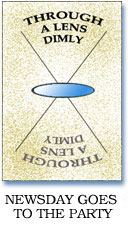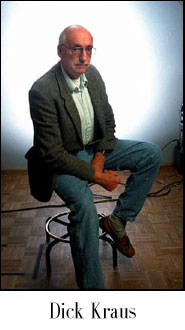|
|
|
|
|
|
THROUGH A LENS DIMLY NEWSDAY
GOES TO THE PARTY "I don't want any more posed photos in the Women's Pages," he declared. "From now on, I want our photos to look like this." He held up the latest copy of Life Magazine. Life Magazine has long since ceased to publish, but at that moment in the late '60's it was the premier example of top of the line, state of the art, edge of the envelope photojournalism. He went on. "This is what I mean." He opened the weekly magazine, which was printed on high quality, glossy stock; not, the toilet paper that rolled off our presses. He showed us a four page spread of lovely, well-lit, crisp pictures of ladies attending some kind of a social event. It was a weekly feature called "Life Goes To The Party." Lou passed before each of us with the spread, tapping each photo with his finger for emphasis as he repeated over and over, "Unposed. Unposed." We looked at the pictures in silence. He looked at us. "Well?" he asked. He stood before me, looking right at me, daring me to question his strategy. "Well, Lou; take a good look at these pictures. They are all beautifully lit and the pictures are taken in several different rooms. Are you aware that Life sends a photographer and a crew of assistants to the location several days in advance of the party so they can assess the conditions and rig electronic flash units in each room to assure quality lighting no matter where the action occurs" Lou started to speak, but I continued. "Then the photographer and his assistants spend the whole day photographing every last detail from the preparation of the canapes to the cleaning up after the party." Poor Lou. I don't think he anticipated opening up this can of worms. I went on. "Are you prepared to have our staff devote that kind of time and effort each time we get a Women's Page assignment? Because, as it stands, given the size of our staff and the number of assignments we are asked to shoot every day, we're lucky to have a full hour to complete such an assignment which is usually squeezed in between a 6 PM high school basketball game and an 8 PM school board meeting." "I don't want any more posed pictures!" Lou stated as he turned and walked out of the Photo Department. I looked over at Harvey who was the Director of Photography and the head of our department. He shrugged and said, "He's the ME." A few weeks later, I got my first assignment for the Women's Pages. It was, of course, sandwiched in between a 3 PM high school baseball game and a 5 PM political candidate's press conference. The assignment was to cover a lady's auxiliary of some church as they held an afternnon tea at the home of one of the committee women to plan for a benefit dance. This was my first "Newsday Goes To The Party." Taking into account the travel time to and from each of my assignments, I would have about 20 minutes at the party. Surely not enough time to set up lights in all of the rooms in which the action would take place. I detest straight flash, so it would have to be bounce. Plus, this wasn't the type of story that would run more than one page. One page? I'd be lucky to get one photo in the paper. But, I was resolved to do the best that I could to satisfy the ME's mandate. I cut out of the high school baseball game as soon as I felt that I had a couple of decent shots, and hi-tailed it to the tea party. The hostess answered the door and let me in after I identified myself. She led me around the downstairs and introduced me to the eleven other women on the committee. The committee chairwoman was in the living room talking with the committee treasurer about how much money they would have to raise to cover the expenses of the benefit dance and still have funds left over for the beneficiary of the benefit. The hostess and the chairwoman of the decorations stayed in the kitchen, brewing the tea and cutting up the finger sandwiches which were being served today. The rest of the committee members were in various other rooms, powdering their noses or talking in various corners of the large house. Ah, yes. Where to begin? Well, let's start in the living room. The chairwoman of the affair and the treasurer were still talking and were joined by several other committee members who were in charge of some other functions. I put my camera to my eye. Egads! The chief chairlady was sitting in a wing chair near the window. The treasurer was on a settee against the opposite wall. Another pair of women were standing against a third wall near the doorway. I couldn't back up far enough to include them all. I dug into my camera bag for my 14mm lens. I made sure that I was shooting absolutely level so as not to introduce keystoning into an already insipid photo. Then, for a second shot, I used a medium-long lens and shot the main chairlady and the treasurer together hoping that the foreshortening effect of the longer lens would pull the two of them together. I knew that one or the other of those two women would be very much out of focus because I was shooting a combination of available light and bounce flash to at least make the lighting appear normal. But, that meant a wide lens aperature which meant little depth of field. I looked at my watch. Oh, shit! If I left right now, I would still be late for the press conference. Let's hope it would start late, like they usually do. It was time to get going, but, I still didn't have a shot that would look at all presentable in the paper, even though I had followed the ME's orders. My name would appear under the pictures (presuming that they would even run) and I would take no pride in being identified as the producer of such crap. So, I did what I had always done in these circumstances. I set-up a photo. I button-holed the chairlady of the event and quizzed her as to the exact intent of this tea. Then I asked her help in gathering the four most important committee members for a photo. At this point I usually get an argument that I must include all twelve members. I explained, as tactfully as possible, that getting twelve people in the photo would end up looking like crap and the resulting heads would be too small to recognize. More importantly, I explained that even if such a bad photo ran, it wouldn't attract any attention from our readers. I explained that the best thing that I could do for this group was to make a picture that would capture the attention of our readers so that they would read the caption and find out what this committee was doing. That usually worked. So I placed three of the women in a tight grouping on the couch with the chairlady holding some of the paperwork that they were using. I asked her to talk about what she was doing so that she looked as natural as possible, cautioning her not to look down at the paper but, rather over the top edge of the page lest her eyes appear to be closed. This was a favorite trick of mine. In the photo, she would appear to be reading from her notes. I would ask the other two women to be looking attentively at the chairlady. And, the fourth woman, usually the hostess, would be leaning over the group while passing a cup of tea that she had just poured. I quickly set up a couple of flash units on light stands. I always tried to duplicate the kind of lighting already in the room to keep the ambiance of the room intact. The extra light enabled me to stop down my lens to gain extra depth of field. I made four or five quick exposures to make sure that I didn't have any blinkers, packed away my equipment and sped to the next assignment, comfortable in my mind that I had made a set-up that was plausible and true to the ideals of what the tea party was all about. When I returned to the paper, later in the day, I souped my film and instead of handing it off to the darkroom staff, I went in and knocked out the three shots that I had made. As soon as the prints came off the drier and had my captions pasted on the backs, I took them out to the Newsroom and into the ME's office. "Lou, here's your "Newsday Goes To The Party" pictures." I handed him the two unposed candid shots. He looked at them. "These are terrible," he said. "We can't run this. "I know, Lou. They really suck. But, that's what you can expect if you want our shooters to try to emulate Life photographers under the pressure of our daily schedule." Then I showed him the set-up shot. It ran in the paper the next day and we never heard any more about Life Goes To The Party.
My conscience never bothered me and I slept very well that night.
|
|||


